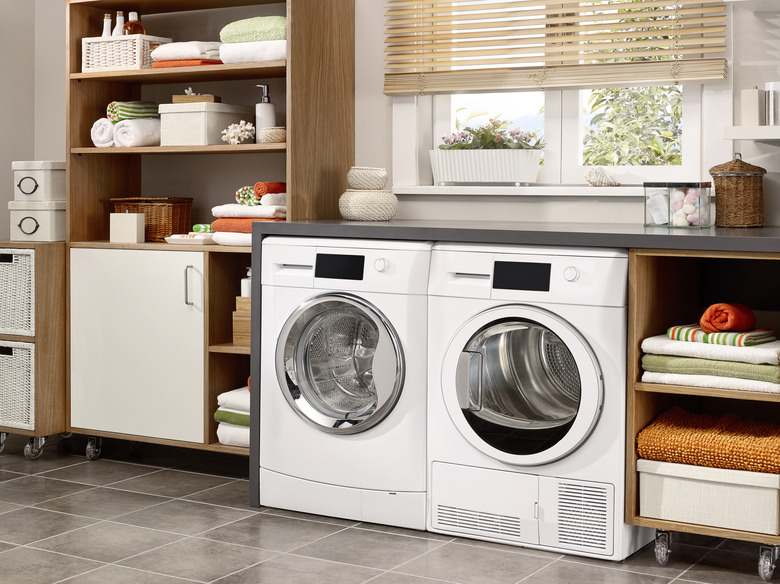How To Relocate The Washer And Dryer Plumbing
We may receive a commission on purchases made from links.
Laundry rooms are no longer an afterthought in home renovations. If you're planning to move your laundry room out of the basement or other area and into a new space closer to your kitchen or bedroom, one of the biggest hurdles you'll need to consider is relocating the washer and dryer plumbing. Incorrectly installed (or improperly maintained) washers and dryers are two of the biggest culprits in causing home damage due to flooding and fire.
Because of the new plumbing and electrical hookups needed, this project usually requires a permit from the local building department, and it will be subject to the same code rules as a new installation. Be sure to check with the local building department for all applicable rules and installation details.
Washing Machine Drain
Washing Machine Drain
Washing machines typically require a 2-inch drain line with a vent. The drain piping starts with a standpipe — a vertical pipe that connects to a P-trap at the bottom and is open at the top to receive the washing machine's drain hose. The vent must be within 60 inches of the P-trap (for a 2-inch drain). After the P-trap, the drain can tie into any suitable existing drain in the house, as long as it's 2 inches or larger.
There are specific standpipe requirements that vary by local code, but in most areas, the P-trap must be between 6 and 18 inches above the floor. The standpipe must extend 18 to 30 inches above the P-trap (some codes allow up to 42 inches above the trap) and terminate above the flood level of the washing machine.
Washing Machine Water Supplies
Washing Machine Water Supplies
Washers need both hot and cold water and are typically supplied by 1/2-inch water pipes. Each supply needs a shutoff valve that is easily accessible. In new installations, it's standard to use a washing machine outlet box containing hot and cold shutoff valves and an inlet for the drain standpipe, all in a sturdy plastic box that mounts to a wall stud. The water supply pipes connect to the shutoff valves, and the standpipe connects to the drain inlet. The box cavity is recessed into the wall so that the valves are neatly tucked away and won't be bumped by activity in the room.
The washer's water hoses screw onto the shutoff valves just like a garden hose to an outdoor hose bib. Washer hoses are prone to leaking or bursting when they age, and this is a common source of house flooding. To protect against this, consider investing in automatic shutoff valves that stop the water flow to the washer if a leak is detected.
Also consider installing water hammer arrestors if you hear pipes banging when the washing machine fills. This is due to water hammer caused by the machine's internal valves quickly shutting off the water. Water hammer is hard on pipes and can lead to leaks and other problems. Some washing machine outlet boxes include valves with preinstalled water hammer arrestors. Or you can add them anytime the future. They simply screw into place between each machine hose and the shutoff valve or between the machine and the hose.
Dryer Ventilation System
Dryer Ventilation System
Installing a proper dryer ventilation system is essential when moving a dryer. Dryer venting is done through a metal duct, typically 4-inch rigid duct, that follows the shortest possible path to the outdoors. Dryers pull in air from the room and heat it on its way to the drum area full of clothes. The air picks up moisture from the clothes and is sent outdoors through the duct. Ventilation to the outdoors is critical to keeping excess moisture and heat out of the house. Gas dryers also need ventilation to keep poisonous gas exhaust from entering the home.
As a rule of thumb, it's best to install a dryer vent duct in an external wall to make the run as short as possible. You'll also want to minimize bends in the vent, which can impede airflow. To keep cold air and animals from migrating into the home through the duct, install a self-closing exhaust vent cap that will ensure your vent isn't letting in air or unwanted pests when the dryer isn't in use.
It's best to use rigid duct to connect directly to the dryer, but if this is impractical, you can use a semi-rigid metal transition duct to run from the back of the dryer to the rigid duct. The transition duct must be UL-listed for safety, and it must be fully exposed; it cannot run through wall, floor, or ceiling cavities. Never use flimsy vinyl or metal-foil duct hoses for any part of the ventilation assembly. These are prone to clogging with lint and present a real fire hazard.
